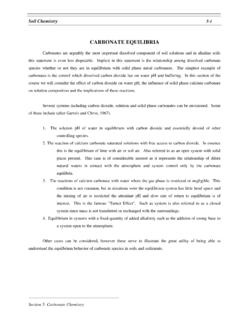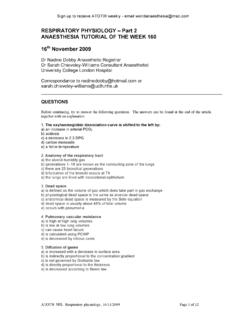Transcription of 128 Diabetic Ketoacidosis - Anaesthesia UK
1 Sign up to receive ATOTW weekly email ATOTW #128. Diabetic Ketoacidosis , 06/04/2009 Page 1 of 9 Diabetic Ketoacidosis Anaesthesia TUTORIAL OF THE WEEK 128 6TH APRIL 2009 William English, North Bristol NHS Trust, Bristol, UK Peter Ford, Royal Devon and Exeter Hospital, Exeter, UK. Correspondence to SELF-ASSESSMENT QUESTIONS Please read the following questions. The answers will be found in the article. 1. What are the characteristic metabolic derangements in Diabetic Ketoacidosis (DKA)? 2. What are the basic principles in the management of a patient with DKA? 3. What is the optimal rate of fall of plasma glucose in the management of DKA? 4. What are the risk factors for and early signs of cerebral oedema complicating DKA treatment? 5. When is it appropriate to convert a patient who has been treated for DKA from intravenous insulin infusion to a subcutaneous regime?
2 Diabetic Ketoacidosis : DEFINITION AND KEY FEATURES Diabetic Ketoacidosis (DKA) is a life threatening medical emergency. It is characterised by hyperglycaemia, dehydration, metabolic acidosis and ketonuria. The criteria for the diagnosis of DKA includes a blood sugar > mmol/l, presence of urinary or plasma ketones, a pH< and a serum bicarbonate of less than 18 mmol/l. The main differential diagnosis is the hyperosmolar hyperglycaemic syndrome which differs in the extent of dehydration, acidosis and ketosis. Patients with hyperosmolar hyperglycaemic syndrome tend present with a pH> Despite significant overlaps between the syndromes the focus of the review will be on the DKA syndrome. As important differences exist between adults and children as regards their presentation and management of DKA, the treatment in either subgroup will be discussed separately.
3 FREQUENCY AND CAUSES Diabetic Ketoacidosis (DKA) primarily occurs in patients with Type I diabetes mellitus but it is being recognised in some Type II The incidence of DKA is estimated at between and 8 episodes per 100 patient years of DKA may be the first presentation of diabetes or may follow a precipitating event. The most common precipitant is an infection however in a large number of cases no identifiable cause can be found (Table 1). Table 1. Common precipitating events of DKA Precipitant Occurrence (%) Infections (commonly urinary tract) 30 Non-compliance with treatment 15 New diagnosis of type I diabetes 5-15 Other stresses (MI, alcohol, pancreatitis, drugs) 5 No cause found 40 Sign up to receive ATOTW weekly email ATOTW #128. Diabetic Ketoacidosis , 06/04/2009 Page 2 of 9 PATHOPHYSIOLOGY DKA is due to an insulin deficiency, together with an excess of the counter-regulatory hormones, glucagon, growth hormone and the catecholamines.
4 The absence of insulin results in poor glucose utilisation by peripheral tissues. Glucagon, growth hormone and the catecholamines increase triglyceride breakdown into free fatty acids and promote glucose production from hepatic gluconeogenesis. The Ketones, acetoacetate and hydroxybutyrate are formed by the beta oxidation of the free fatty acids. Hence resulting in hyperglycaemia and the formation of ketoacids which are the primary metabolic derangements in DKA. The secondary consequences of these primary derangements include metabolic acidosis and an osmotic diuresis. Metabolic acidosis is caused by the production of H+ ions by the dissociation of ketoacids. The accumulation of ketoacids leads to an elevated anion gap. This is a key feature of DKA. Initially as the blood sugar rises there is a shift of fluid from the intracellular to the extracellular compartment with subsequent dilution.
5 Once the blood sugar level exceeds the renal threshold for glucose, around 12 mmol/l, glycosuria occurs followed by an obligatory osmotic diuresis, resulting in a loss of water from the extracellular compartment. This hyperglycaemia induced osmotic diuresis as well as causing a urinary loss of water and glucose will also cause a loss of, ketones, sodium, potassium and phosphate in the urine. At presentation patients are often severely dehydrated with marked serum electrolyte disturbances. CLINICAL FEATURES There is a wide spectrum of severity of illness in patients presenting with DKA. Classically patients present with a history of thirst, polyuria and polydipsia although these are not invariably present. As discussed, Diabetes Mellitus may not have been previously diagnosed.
6 Other symptoms may include: Weakness and lethargy Nausea and vomiting Abdominal pain Weight loss. Common general physical signs are: Evidence of dehydration Tachycardia and hypotension Kussmaul respiration (deep rapid respiration to provide respiratory compensation for metabolic acidosis) Ketotic breath (fruity acetone smell due to exhaled ketones) Temperature is usually normal or low even in the presence of an underlying Altered consciousness and confusion INVESTIGATIONS Initial investigations are aimed at confirming the diagnosis, estimating the severity and identifying underlying causes. Blood glucose measured hourly This will be grossly elevated at presentation but can rarely be normal if there has been administration of insulin, resulting in correction of the blood sugar but not the acidaemia. When the blood sugar is grossly elevated at presentation, point of care testing can be inaccurate and therefore samples should be sent to the laboratory initially.
7 Urine test for ketones If the nitroprusside method is used hydroxybutyrate will not be measured. As hydroxybutyrate is the main ketone produced in DKA for on-going assessment of ketonaemia direct measurement of serum hydroxybutyrate is recommended but is dependent on laboratory availability. Serum urea and electrolytes These should be measured every 2-4 hours initially. Sodium As already discussed hyperglycaemia will cause a dilutional hyponatraemia. The measured serum Na can be corrected by adding for each elevation of serum glucose over Correction formula: Corrected Na = Measured Na + [Plasma Glucose (mmol/l) ] Sign up to receive ATOTW weekly email ATOTW #128. Diabetic Ketoacidosis , 06/04/2009 Page 3 of 9 Potassium In DKA there is a total body deficit of potassium but because of acidosis and dehydration initial serum levels may be within the normal range or be elevated.
8 Serum levels must be regularly checked because correction of the acidosis and administration of insulin can result in a precipitous drop in serum potassium because of the intracellular movement of potassium. Urea and creatinine Renal impairment may be present at presentation. Elevated acetoacetate levels may cause a falsely elevated creatinine level if the calorimetric method is used to measure the serum creatinine. Serum Osmolality Calculated as 2(Na) + Glucose + Urea. If a patient in DKA is comatose with an osmolality less than 330mOsm/kg then other sources for coma should be sought. Venous or arterial blood gas This is required every 2-4 hours. Venous blood gases or venous serum bicarbonate are an acceptable alternative to arterial blood gas sampling in the initial management of DKA as studies have confirmed that venous blood pH closely reflects arterial blood pH in these patients.
9 The venous pH is units lower than the arterial Anion gap An elevated anion gap metabolic acidosis is a key feature of DKA. Anion gap is calculated as (Serum Na + K) (Serum HCO3 + Cl). Normal values are 8 12mmol/l. Full blood count An increased white blood cell count in the range 10-15x 109/ l is characteristic of DKA and is not indicative of infection. However a count >25 x 109 should raise concern that an infection is Amylase Amylase is often raised in the absence of pancreatitis. This may cause diagnostic confusion, especially in the presence of abdominal pain. Chest X-ray, blood cultures, urine cultures, ECG and cardiac enzymes should be considered to investigate potential underlying causes. Children should be weighed to guide fluid and drug therapy. If this is not possible an estimated weight should be calculated. MANAGEMENT OF ADULTS IN Diabetic Ketoacidosis Initial assessment and resuscitation Patients with DKA may be severely unwell and comatose.
10 Initial assessment involves confirmation of the diagnosis and a rapid assessment of Airway, Breathing ,Circulation and Disability. Intravenous access is obtained as soon as possible and blood tests (mentioned above) taken for urgent analysis including blood for culture. There should be application of 100% oxygen via a face mask with a reservoir bag. The basic principles of DKA management are; - rapid restoration of adequate circulation and perfusion with isotonic intravenous fluids - gradual rehydration and restoration of depleted electrolytes - insulin to reverse ketosis and hyperglycaemia - careful, regular monitoring of clinical sings and laboratory tests to detect and treat complications Fluids (see Table 2) Initially fluid therapy is aimed at rapid restoration of the intravascular volume. In the first hour saline is given at a rate of 15-20mls/kg or an average litres.

















